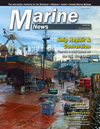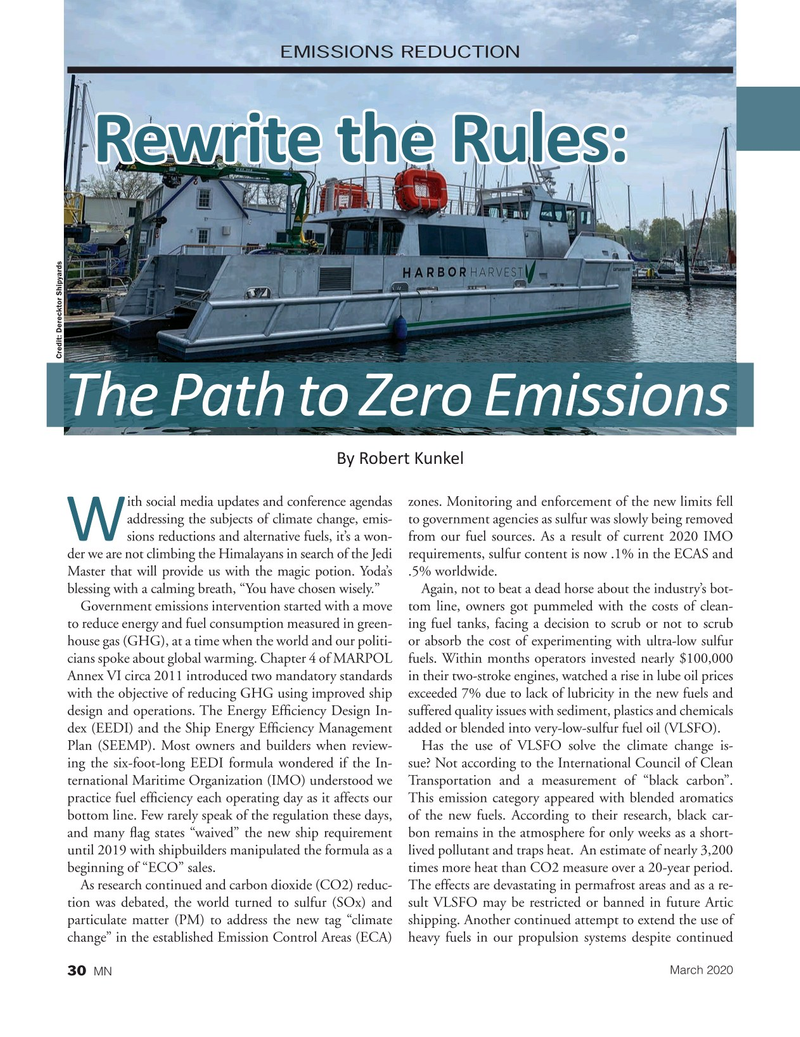
Page 30: of Marine News Magazine (March 2020)
Workboat Conversion & Repair
Read this page in Pdf, Flash or Html5 edition of March 2020 Marine News Magazine
EMISSIONS REDUCTION
Rewrite the Rules:
Credit: Derecktor Shipyards
The Path to Zero Emissions
By Robert Kunkel ith social media updates and conference agendas zones. Monitoring and enforcement of the new limits fell addressing the subjects of climate change, emis- to government agencies as sulfur was slowly being removed
Wsions reductions and alternative fuels, it’s a won- from our fuel sources. As a result of current 2020 IMO der we are not climbing the Himalayans in search of the Jedi requirements, sulfur content is now .1% in the ECAS and
Master that will provide us with the magic potion. Yoda’s .5% worldwide.
blessing with a calming breath, “You have chosen wisely.” Again, not to beat a dead horse about the industry’s bot-
Government emissions intervention started with a move tom line, owners got pummeled with the costs of clean- to reduce energy and fuel consumption measured in green- ing fuel tanks, facing a decision to scrub or not to scrub house gas (GHG), at a time when the world and our politi- or absorb the cost of experimenting with ultra-low sulfur cians spoke about global warming. Chapter 4 of MARPOL fuels. Within months operators invested nearly $100,000
Annex VI circa 2011 introduced two mandatory standards in their two-stroke engines, watched a rise in lube oil prices with the objective of reducing GHG using improved ship exceeded 7% due to lack of lubricity in the new fuels and design and operations. The Energy Ef? ciency Design In- suffered quality issues with sediment, plastics and chemicals dex (EEDI) and the Ship Energy Ef? ciency Management added or blended into very-low-sulfur fuel oil (VLSFO).
Plan (SEEMP). Most owners and builders when review- Has the use of VLSFO solve the climate change is- ing the six-foot-long EEDI formula wondered if the In- sue? Not according to the International Council of Clean ternational Maritime Organization (IMO) understood we Transportation and a measurement of “black carbon”. practice fuel ef? ciency each operating day as it affects our This emission category appeared with blended aromatics bottom line. Few rarely speak of the regulation these days, of the new fuels. According to their research, black car- and many ? ag states “waived” the new ship requirement bon remains in the atmosphere for only weeks as a short- until 2019 with shipbuilders manipulated the formula as a lived pollutant and traps heat. An estimate of nearly 3,200 beginning of “ECO” sales. times more heat than CO2 measure over a 20-year period.
As research continued and carbon dioxide (CO2) reduc- The effects are devastating in permafrost areas and as a re- tion was debated, the world turned to sulfur (SOx) and sult VLSFO may be restricted or banned in future Artic particulate matter (PM) to address the new tag “climate shipping. Another continued attempt to extend the use of change” in the established Emission Control Areas (ECA) heavy fuels in our propulsion systems despite continued
March 2020 30 MN

 29
29

 31
31
